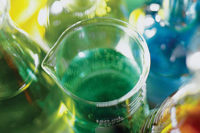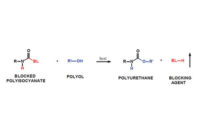Q&A About Polyurethanes - May 2012

I am currently formulating a waterborne contact cement, and I have been observing a change in performance over time. What options exist to resolve this issue?
In order to address this situation, it’s important to look at a number of options, ranging from the handling and storage of your raw materials and finished adhesives to an outright reformulation of the adhesive.
Measuring the pH of your formulated adhesive should be the first step. A decrease in pH indicates changes in the formulation and would be expected to correlate with variations in performance. For example, it is known that the properties of polychloroprene latexes change as the material ages. This occurs due to the hydrolysis of a labile chlorine atom on the backbone of the polymer. Hydrochloric acid is generated and leads to a drop in pH. The reaction ultimately leads to the generation of enough hydrochloric acid that the emulsifier used to stabilize the latex is no longer effective and the latex coagulates—but this is an extreme situation.
The rate of hydrochloric acid production in the polychloroprene latex raw material and the finished adhesive is influenced by storage conditions. As with many chemical reactions, the production of hydrochloric acid and the drop in pH increases at elevated temperatures. It is recommended that the latex be stored in the temperature range of 10-25°C. Temperatures greater than 30°C should be avoided. If the pH has dropped a moderate amount, it can be readjusted to the desired level using 10% potassium hydroxide. A dispersion of zinc oxide can be added to polychloroprene latexes to act as an acid acceptor and help prevent the drop in pH.
A decrease in pH can be a more critical event for certain types of adhesives. Typical foam-bonding adhesives are used as one- or two-component systems. The one-component adhesives are typically formulated to a pH of 8-9. This allows the adhesive to “break” during the spraying operation and produce a film with aggressive wet tack properties. These adhesive systems start with a lower pH, and a further decline can lead to coagulation of the polymer. Thus, systems of this type must be used promptly to avoid the consequences of the typical production of acid by polychloroprene polymers. Formulation instability can also be a result of exposure of the latex to multivalent cations. Sources for these contaminants can include fillers or mixing vessels.
Formulating the adhesive with an alternative polychloroprene latex may also provide a solution to the performance problem. This may be a longer term project but could eventually produce a more reliable adhesive. Some commercially available dispersions have been designed to have an extended shelf life as a raw material and in formulated systems. One product is made by pre-hydrolyzing the labile chlorine from the polymer during the production process and then readjusting the pH to a typical level of 12-13. The hydrolysis process yields a latex with hydroxyl groups on the polymer, which are potential sites for crosslinking reactions. This product is a fast-crystallizing, high-solids latex suitable for foam bonding applications. Another product with excellent long-term stability is supplied at 30% solids and a pH of 9. This product is suitable for many contact adhesive applications as supplied without the need for additional formulating.
For additional information on the topics addressed or to ask another question, email jeff.dormish@bayer.com with the subject line “Polyurethane Q&A.”
Any views or opinions expressed in this column are those of the author and do not represent those of Adhesives & Sealants Industry, its staff, Editorial Advisory Board or BNP Media.
Looking for a reprint of this article?
From high-res PDFs to custom plaques, order your copy today!








